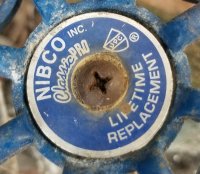I had a valve that looked just like this, a nibco. It leaked from the packing nut, and didn't close completely. The valve was copper sweat, and I needed to be able to isolate the line to do some work on a bathroom downstream. I considered re-packing and rebuilding the valve, but it was seemed easier to just cut it out and sweat in a ball valve where it was. If you don't have the skills or tools to sweat in a new valve, you could replace the valve with a compression type valve.
If you want to rebuild the valve, unscrew the packing nut and the bonnet nut and remove the stem. Examine the seat washer at the end of the and identify a replacement from your supplies, or purchase a the correct washer. You can buy a kit of washers online for not too much, or you can find the exact washer at a hardware store or big box.
For the packing, remove the packing washer under the packing nut, and then you have two choices. Identify a replacement packing washer, or use teflon valve packing. Make sure the packing you use is appropriate for potable water, unless this is area is seperated from the potable supply as required by the codes. PTFE packing usually is. Before you do this though, you could try just tightening the packing nut, as that usually buys you a few years unless the washer is really worn out.
Removing the stem may be difficult. Select a well fitting wrench that will not round off the bonnet nut easily, and expect you will need a lot of torque to break it loose. While I have rebuilt many valves, it's usually when it's a situation where it would be difficult to replace the valve, such as an original valve on 1920s threaded brass plumbing. Sometimes it works sometimes it doesn't. If it turns out the stem is broken, you need a plan to get the water back on.
Edit: Looking at Jadnashua's response, he is right, if it is a gate valve you cannot rebuild unless you have a new stem from an identical valve, and you can get the old stem completely out and the problem is with the stem. I also had one of these nibco gate valves I recently cut out, so that could be the case. When you're replacing it with a new valve it doesn't really matter.











